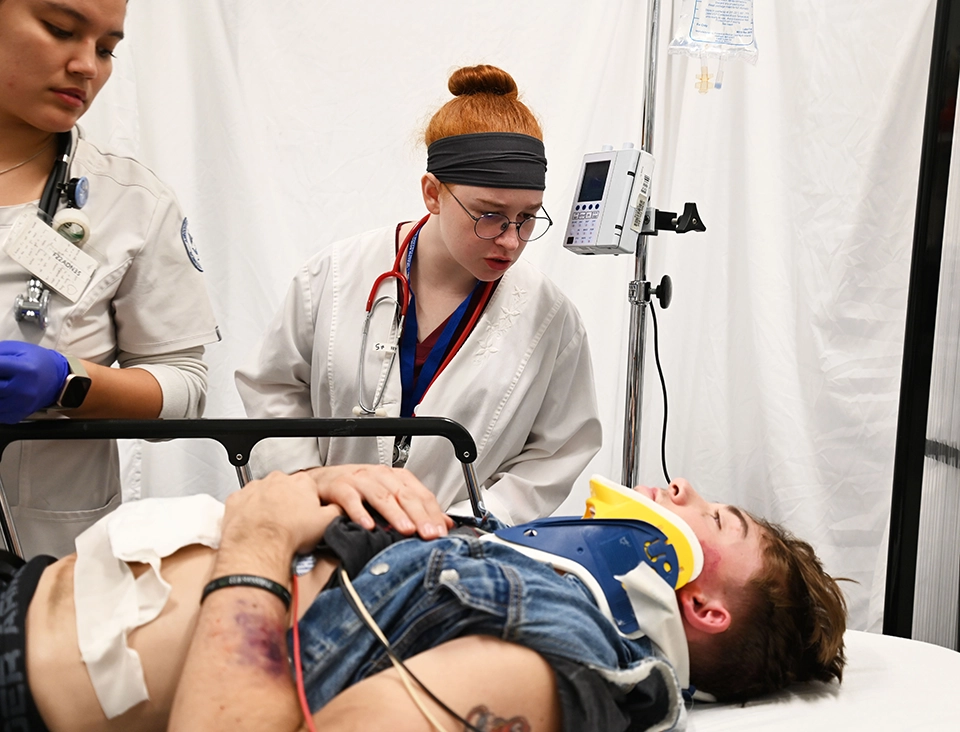Blinn theatre students bring the drama during health sciences simulation exercise
Two-day collaborative training helps theatre and health sciences students hone their skills

October 23, 2023
Donning a white lab coat, stethoscope, and clipboard, Blinn theatre major Ashley Wienecke assertively asks a room of Blinn College District Associate Degree Nursing (ADN) students “Who’s in charge here?” Wienecke isn’t playing a doctor, but instead a mental health patient in disguise who has breached hospital security and has gone unnoticed.
“She completely fooled me,” second-year ADN student Kyndal Coufal said. “It’s great training as to what happens in the hospital because sometimes you have doctors come in that you’ve never seen before and now I know to always check credentials.”
This is just one of the scenarios featuring actor-patients, known as “standardized patients,” meant to test the skills of students in Blinn’s ADN, Emergency Medical Services (EMS), Physical Therapist Assistant (PTA), and Radiologic Technology programs during a recent simulation exercise at the RELLIS Academic Complex.
“In school, they teach us the skills, they teach us communication with family members, but putting it into play in real life is so valuable,” Coufal said. “I want to work in critical care, so being in this simulation helps with our confidence and getting ready to deal with combative patients or family members, or people who just walk in.”
This round of simulation exercises marks a new collaboration, with Blinn theatre students portraying standardized patients for the first time. This partnership provides students in Professor Greg Wise’s Acting I: DRAM 1351 course with valuable improvisation acting experience and gives health sciences students hands-on training with “live” patients in a controlled environment.
“This really prepares the acting students to think on their feet, to be in the moment, and to really exercise those muscles of improvisation,” Wise said. “By them playing the same role over and over with different health sciences students as their audience, they get to practice different tactics, which is a real challenge for them.”
Other mock scenarios included a motorcycle accident with gunshot wounds, a patient experiencing a stroke, a fishing injury, a patient collapsing on a volleyball court, a fall victim, and a young mother surrendering her newborn. The immersive simulations were repeated four times for different health sciences student groups, emphasizing a hands-on collaborative experience between initial responders, nursing staff, and other hospital departments. The addition of theatre students was a beneficial resource that the health sciences and theatre arts staff hope to continue.
“The theatre students and collaboration has been amazing,” said ADN Instructor Shandolyn Smith. “My favorite part of this is that it gives all the students a safe environment to practice. If they’re going to make mistakes, we want them to do it here, so that out in the real-world with real patients, they’re prepared.”
Simulation exercises are a vital part of student training in Blinn’s Division of Health Sciences. Designed to complement the clinical experience Blinn students receive in area hospitals, the 16,000-square-foot Simulation and Clinical Labs at the RELLIS Academic Complex feature the latest tools and technology available.
“I think the sheer amount of intensity and pressure that this exercise brings teaches the health sciences students how to keep their cool around their patients,” Wienecke said. “Whether it’s a family member that’s hysterical or it’s a psychiatric patient battling delusions, you have to remain calm in that moment. You have to keep your focus on your patient and your fundamentals.”
For more information about Blinn’s Division of Health Sciences, visit www.blinn.edu/health-sciences.
To learn more about Blinn’s Theatre Arts Program, visit www.blinn.edu/theatre.
Enjoy this article? Share it with one click!